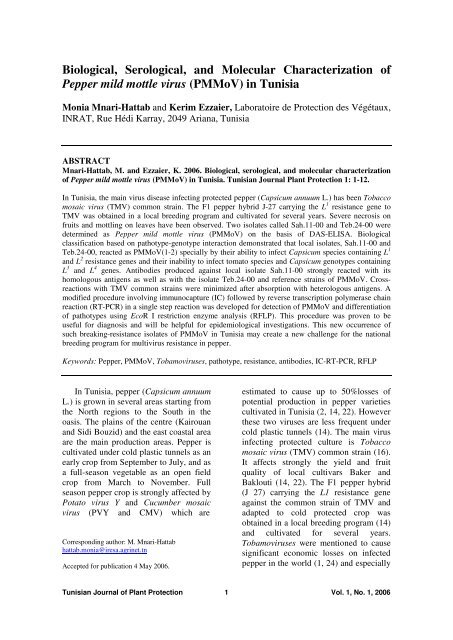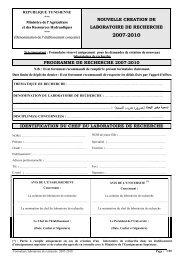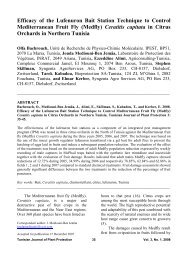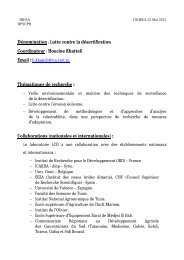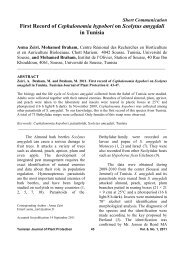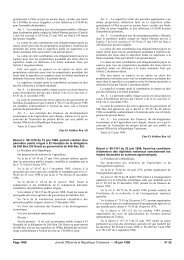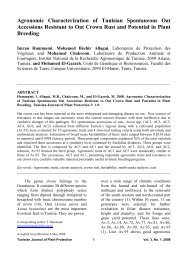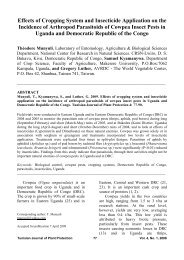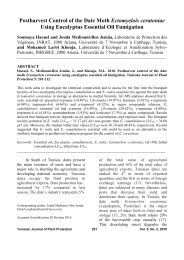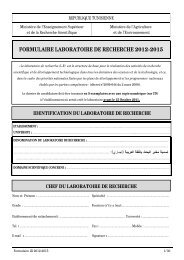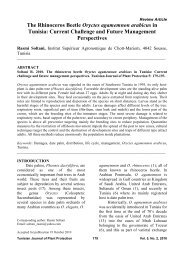Biological, Serological, and Molecular Characterization of ... - Iresa
Biological, Serological, and Molecular Characterization of ... - Iresa
Biological, Serological, and Molecular Characterization of ... - Iresa
You also want an ePaper? Increase the reach of your titles
YUMPU automatically turns print PDFs into web optimized ePapers that Google loves.
<strong>Biological</strong>, <strong>Serological</strong>, <strong>and</strong> <strong>Molecular</strong> <strong>Characterization</strong> <strong>of</strong><br />
Pepper mild mottle virus (PMMoV) in Tunisia<br />
Monia Mnari-Hattab <strong>and</strong> Kerim Ezzaier, Laboratoire de Protection des Végétaux,<br />
INRAT, Rue Hédi Karray, 2049 Ariana, Tunisia<br />
ABSTRACT<br />
Mnari-Hattab, M. <strong>and</strong> Ezzaier, K. 2006. <strong>Biological</strong>, serological, <strong>and</strong> molecular characterization<br />
<strong>of</strong> Pepper mild mottle virus (PMMoV) in Tunisia. Tunisian Journal Plant Protection 1: 1-12.<br />
In Tunisia, the main virus disease infecting protected pepper (Capsicum annuum L.) has been Tobacco<br />
mosaic virus (TMV) common strain. The F1 pepper hybrid J-27 carrying the L 1 resistance gene to<br />
TMV was obtained in a local breeding program <strong>and</strong> cultivated for several years. Severe necrosis on<br />
fruits <strong>and</strong> mottling on leaves have been observed. Two isolates called Sah.11-00 <strong>and</strong> Teb.24-00 were<br />
determined as Pepper mild mottle virus (PMMoV) on the basis <strong>of</strong> DAS-ELISA. <strong>Biological</strong><br />
classification based on pathotype-genotype interaction demonstrated that local isolates, Sah.11-00 <strong>and</strong><br />
Teb.24-00, reacted as PMMoV(1-2) specially by their ability to infect Capsicum species containing L 1<br />
<strong>and</strong> L 2 resistance genes <strong>and</strong> their inability to infect tomato species <strong>and</strong> Capsicum genotypes containing<br />
L 3 <strong>and</strong> L 4 genes. Antibodies produced against local isolate Sah.11-00 strongly reacted with its<br />
homologous antigens as well as with the isolate Teb.24-00 <strong>and</strong> reference strains <strong>of</strong> PMMoV. Crossreactions<br />
with TMV common strains were minimized after absorption with heterologous antigens. A<br />
modified procedure involving immunocapture (IC) followed by reverse transcription polymerase chain<br />
reaction (RT-PCR) in a single step reaction was developed for detection <strong>of</strong> PMMoV <strong>and</strong> differentiation<br />
<strong>of</strong> pathotypes using EcoR I restriction enzyme analysis (RFLP). This procedure was proven to be<br />
useful for diagnosis <strong>and</strong> will be helpful for epidemiological investigations. This new occurrence <strong>of</strong><br />
such breaking-resistance isolates <strong>of</strong> PMMoV in Tunisia may create a new challenge for the national<br />
breeding program for multivirus resistance in pepper.<br />
Keywords: Pepper, PMMoV, Tobamoviruses, pathotype, resistance, antibodies, IC-RT-PCR, RFLP<br />
In Tunisia, pepper (Capsicum annuum<br />
L.) is grown in several areas starting from<br />
the North regions to the South in the<br />
oasis. The plains <strong>of</strong> the centre (Kairouan<br />
<strong>and</strong> Sidi Bouzid) <strong>and</strong> the east coastal area<br />
are the main production areas. Pepper is<br />
cultivated under cold plastic tunnels as an<br />
early crop from September to July, <strong>and</strong> as<br />
a full-season vegetable as an open field<br />
crop from March to November. Full<br />
season pepper crop is strongly affected by<br />
Potato virus Y <strong>and</strong> Cucumber mosaic<br />
virus (PVY <strong>and</strong> CMV) which are<br />
Corresponding author: M. Mnari-Hattab<br />
hattab.monia@iresa.agrinet.tn<br />
Accepted for publication 4 May 2006.<br />
estimated to cause up to 50%losses <strong>of</strong><br />
potential production in pepper varieties<br />
cultivated in Tunisia (2, 14, 22). However<br />
these two viruses are less frequent under<br />
cold plastic tunnels (14). The main virus<br />
infecting protected culture is Tobacco<br />
mosaic virus (TMV) common strain (16).<br />
It affects strongly the yield <strong>and</strong> fruit<br />
quality <strong>of</strong> local cultivars Baker <strong>and</strong><br />
Baklouti (14, 22). The F1 pepper hybrid<br />
(J 27) carrying the L1 resistance gene<br />
against the common strain <strong>of</strong> TMV <strong>and</strong><br />
adapted to cold protected crop was<br />
obtained in a local breeding program (14)<br />
<strong>and</strong> cultivated for several years.<br />
Tobamoviruses were mentioned to cause<br />
significant economic losses on infected<br />
pepper in the world (1, 24) <strong>and</strong> especially<br />
Tunisian Journal <strong>of</strong> Plant Protection 1<br />
Vol. 1, No. 1, 2006
in Mediterranean area (12, 30). These<br />
Tobamoviruses causing Pepper mild<br />
mottle virus (PMMoV) disease have been<br />
ordered on the basis <strong>of</strong> their interaction<br />
with the L gene for resistance in pepper<br />
genotype. Based upon their ability to<br />
overcome the resistance conferred by<br />
allelic series <strong>of</strong> Capsicum spp. genes<br />
known as L 1 , L 2 <strong>and</strong> L 3 they have been<br />
designed as pathotypes P 1 , P 1,2 ,<br />
respectively (11). In the Capsicum genus,<br />
four alleles <strong>of</strong> the Tobamovirus resistance<br />
gene L have been discovered. The allele<br />
L 4 confers resistance to the more<br />
aggressive pathotype PMMoV 1,2,3 which<br />
was originally found in some lines <strong>of</strong><br />
Capsicum chacoense <strong>and</strong> was introduced<br />
in the Hungary pepper type “Himes F1”<br />
(24).<br />
In the last five years, severe necrosis<br />
on fruits <strong>and</strong> mottling on leaves similar to<br />
those caused by Tobamoviruses have<br />
been observed on the J27 F1 resistant<br />
hybrid cultivated in the central coastal<br />
area. Paying attention to these<br />
observations, we attempt in our study to<br />
identify <strong>and</strong> characterize this virus using<br />
biological, serological, <strong>and</strong> molecular<br />
tools. Host ranges, serological <strong>and</strong><br />
molecular reactions <strong>of</strong> these isolates were<br />
compared to those <strong>of</strong> reference isolates.<br />
MATERIALS AND METHODS<br />
Virus isolates <strong>and</strong> strains. Two virus<br />
isolates Sah.11-00 <strong>and</strong> Teb.24-00 were<br />
taken in this study with reference isolates<br />
<strong>of</strong> four strains belonging to the<br />
Tobamovirus group, kindly supplied by<br />
Gebre-Selassie from INRA Avignon-<br />
France (1998). They are described in<br />
Table 1. The studied isolates were<br />
collected from J27 pepper hybrid plants<br />
grown under cold plastic tunnels during<br />
early season crop 2000/2001 in two<br />
regions Teboulba <strong>and</strong> Sahline situated in<br />
central coastal area <strong>of</strong> Tunisia. Severe<br />
Table 1. Strains <strong>and</strong> isolates used in this study<br />
Isolates Original host Country Authors<br />
ToMV: SM2 Tomato France Messiaen <strong>and</strong> Maison, 1964 (21)<br />
TMV: Vi 76 Pepper France Gebre-Selassié <strong>and</strong> collaborators (12)<br />
PMMoV (1-2): Adam Pepper France Gebre-Selassié <strong>and</strong> collaborators (12)<br />
PMMoV (1-2-3): Eve Pepper France Gebre-Selassié <strong>and</strong> collaborators (12)<br />
Sah.11-00 Pepper Tunisia This work<br />
Teb.24-00 Pepper Tunisia This work<br />
necrotic symptoms on fruits <strong>and</strong> mottling<br />
have been observed on leaves <strong>of</strong> J27<br />
infected plants. All reference <strong>and</strong> local<br />
isolates were long-term stored by<br />
desiccation <strong>of</strong> small amounts <strong>of</strong> leaf<br />
materials <strong>of</strong> pepper over calcium chloride<br />
(CaCl 2 ) at 4°C according to the method<br />
described by Bos (3).<br />
<strong>Biological</strong> tests. Fresh collected or<br />
calcium chloride conserved dried leaves<br />
were ground in 0.03 M phosphate buffer<br />
(pH 7.2) <strong>and</strong> containing 0.2% Sodium<br />
diethyldithiocarbamate (Na-DIECA) at<br />
the rate 1:4. Activated charcoal (75<br />
mg/ml buffer) <strong>and</strong> celite were added to<br />
the extract. Inoculation was made by<br />
rubbing the extract on 5-leaf stage plants<br />
for each isolate tested. The isolates were<br />
cloned after two successive passages on<br />
Nicotiana glutinosa. A single local lesion<br />
was used to propagate the virus in each<br />
time. Virus cultures were maintained in<br />
Tunisian Journal <strong>of</strong> Plant Protection 2<br />
Vol. 1, No. 1, 2006
pepper J27 F1 hybrid <strong>and</strong> propagated on<br />
Nicotiana benthamiana. Inoculated<br />
pepper plants <strong>and</strong> other indicator plants<br />
were subsequently transferred into an<br />
insect pro<strong>of</strong> glasshouse with temperature<br />
ranging from 25 to 28°C during day <strong>and</strong><br />
from 12 to 15°C at night. Host range tests<br />
were performed with two to four plants<br />
per species (Table 3). Symptoms were<br />
scored four to five weeks after<br />
inoculation. Back inoculation to at least<br />
two plants <strong>of</strong> Datura stramonium or N.<br />
glutinosa from non-inoculated leaves was<br />
made.<br />
<strong>Serological</strong> tests. <strong>Serological</strong> assays<br />
were carried out using the st<strong>and</strong>ard<br />
s<strong>and</strong>wich DAS ELISA according to Clark<br />
<strong>and</strong> Adams (1977) on pepper samples<br />
showing virus like symptoms to check for<br />
common viruses TMV, PVY, CMV <strong>and</strong><br />
for new virus infection with PMMoV.<br />
Indirect ELISA test was performed<br />
according to Lommel <strong>and</strong> collaborators<br />
(19) to determine the obtained antibody<br />
titer. The antibodies used to detect PVY<br />
were locally produced in the laboratory <strong>of</strong><br />
plant protection at INRAT; those used to<br />
detect CMV were kindly supplied by Drs<br />
Marchoux <strong>and</strong> Gebre-Selassie from<br />
INRA Avignon. PMMoV sera were<br />
purchased from BIO-RAD Phytodiagnostics<br />
(France) <strong>and</strong> used according<br />
to the manufacturer’s conditions.<br />
Virus purification <strong>and</strong> antiserum<br />
production. The isolate Sah.11-00 was<br />
purified according to the method<br />
described by Gebre-Selassie <strong>and</strong><br />
Marchoux (11). N. benthamiana was used<br />
for propagating the virus. Systemically<br />
infected leaves were homogenized in 0.5<br />
M phosphate buffer pH 7.2 (Na 2 HPO 4 -<br />
KH 2 PO 4 ) containing 1% (v/v) <strong>of</strong> 2-<br />
mercaptoethanol with the ratio <strong>of</strong> 100 g<br />
leaf material per 200 ml <strong>of</strong> buffer. The<br />
homogenate was clarified by adding 8%<br />
(v/v) n-butanol using centrifugation at a<br />
low speed centrifugation at 10,000 x g for<br />
30 min. PEG 6,000 <strong>and</strong> NaCl were added<br />
to the supernatant in order to give a final<br />
concentration <strong>of</strong> 3% <strong>and</strong> 1% (w/v),<br />
respectively. A second precipitation by<br />
PEG was performed with Triton X-100<br />
being added (5% v/v) to the supernatant.<br />
Virus particles were further purified by<br />
two cycles <strong>of</strong> differential centrifugation:<br />
90,000 x g for 90 min <strong>and</strong> 10,000 x g for<br />
15 min. The obtained pellet was<br />
resuspended in a 1 mM EDTA buffer, pH<br />
7.2. Purified virus was stored at –18°C<br />
until use.<br />
Virus concentration <strong>and</strong> purification<br />
yield were estimated using a specific<br />
extinction coefficient (A 0.1% 1 cm at 260<br />
ηm) = 3.18 (30).<br />
A rabbit was immunized by injecting<br />
0.5 mg <strong>of</strong> purified virus emulsified with<br />
an equal volume <strong>of</strong> Freund’s complete<br />
adjuvant. Four intramuscularly injections<br />
were performed at one-week interval <strong>and</strong><br />
three more injections two week spaced.<br />
Bleedings started one month after the first<br />
immunization.<br />
Absorption <strong>of</strong> serum. IgGs <strong>of</strong> the<br />
obtained antiserum were purified by<br />
chromatography column sepharose CL-<br />
4B protein A (from Pharmacia) <strong>and</strong><br />
absorbed according to Dijkstra <strong>and</strong> Jager<br />
(10) against virus-free plant material <strong>and</strong><br />
SM2 TMV strain. Sap extracts from<br />
virus-free plants (N. benthamiana) <strong>and</strong><br />
SM2 infected plants were squeezed<br />
through cheesecloth <strong>and</strong> diluted 20 times<br />
in PBS-T. Antibodies were diluted in the<br />
obtained plant sap. The mixture was<br />
incubated for one hour at 37°C <strong>and</strong><br />
centrifuged at 8,000 x g for 20 min. The<br />
supernatant (absorbed antiserum) was<br />
used in indirect ELISA.<br />
<strong>Molecular</strong> tests.<br />
Oligonucleotide primers. In this<br />
investigation, the set <strong>of</strong> PMMoV specific<br />
primers P12/3 (5’-ACAgCgTTTggATCTTAgTAT-3’)<br />
<strong>and</strong> P12/3A (5’-<br />
gTgCggTCTTAATAACCTCA-3’) were<br />
used (28).<br />
IC-RT-PCR. Immunocapture (IC) was<br />
performed according to Wetzel <strong>and</strong><br />
collaborators (31). Each PCR tube (0.2 ml<br />
Biozym) was incubated 3 hours at 37°C<br />
with 100 µl <strong>of</strong> PMMoV or TMV<br />
antiserum diluted in carbonate buffer pH<br />
9.6 as used in ELISA test, then washed<br />
Tunisian Journal <strong>of</strong> Plant Protection 3<br />
Vol. 1, No. 1, 2006
three times with 150 µl <strong>of</strong> PBST at pH<br />
7.4 (137 mM NaCl, 1.5 mM KH 2 PO 4, 8<br />
mM Na 2 HPO 4, 2.7 mM KCl) containing<br />
0.05 % (v/v) Tween 20. The plant<br />
samples infected by PMMoV <strong>and</strong> TMV<br />
were ground in ELISA extraction buffer<br />
(PBST containing 2% (w/v) <strong>of</strong><br />
Polyvinylpyrrolidon <strong>and</strong> 0.2 % (w/v) <strong>of</strong><br />
bovine serum albumin). The homogenate<br />
was spun at 2,000 x g for 5 min at 4°C.<br />
Hundred microliters <strong>of</strong> the supernatant<br />
were added to coated tubes <strong>and</strong> submitted<br />
to an immunocapture phase for 2 hours at<br />
30°C. Then, they were washed 3 times<br />
with PBST buffer <strong>and</strong> one more with<br />
sterile bidistilled water. The detection<br />
method was based on one-tube RT-PCR<br />
assays using Titan kit from Roche<br />
diagnostics (Penzberg, Germany)<br />
according to manufacturer's conditions. A<br />
mix <strong>of</strong> 50 µl was prepared as following:<br />
0.2 mM <strong>of</strong> each dATP, dCTP, dGTP,<br />
dTTP. 0.4 µM <strong>of</strong> each primer; 5mM<br />
DTT; 10 µl <strong>of</strong> (5 x RT-PCR) buffer<br />
containing 1.5 mM MgCl 2 <strong>and</strong> 1 µl <strong>of</strong><br />
AMV <strong>and</strong> Exp<strong>and</strong> High fidelity PCR<br />
system. The volume <strong>of</strong> mix was adjusted<br />
with sterile bidistilled water <strong>and</strong> added to<br />
each coated tube.<br />
The amplification was carried out in a<br />
Biometra Uno II programmed for one<br />
cycle <strong>of</strong> 50°C for 30 min <strong>and</strong> a second<br />
cycle <strong>of</strong> 94°C for 2 min followed by 35<br />
cycles (denaturing at 94°C for 30 s,<br />
annealing at 50°C for 1 min <strong>and</strong> extension<br />
at 68°C for 1 min) <strong>and</strong> terminated with a<br />
final extension cycle at 68 °C for 10 min.<br />
IC-RT-PCR-RFLP. RFLP analysis<br />
was performed for Sah.11-00 <strong>and</strong> Teb.24-<br />
00 isolates <strong>and</strong> reference strains PMMoV<br />
(1-2) <strong>and</strong> PMMoV (1-2-3) by digesting<br />
the amplified product obtained from IC-<br />
RT-PCR with primers P12/3 <strong>and</strong> P12/3A<br />
with EcoR I enzyme according to<br />
manufacturers conditions. PCR products<br />
<strong>and</strong> digested fragments were run in a 1%<br />
(w/v) agarose gel contained ethidium<br />
bromide in TAE buffer (40 mM Trisacetate,<br />
1 mM EDTA) under a 100 mA<br />
<strong>and</strong> were visualized with a UV<br />
transilluminator at 312 nm.<br />
Absorbance at 405 nm<br />
RESULTS<br />
Purification <strong>and</strong> serology. Concentration<br />
<strong>of</strong> purified virus <strong>of</strong> isolate<br />
Sah.11-00 was estimated to 0.4 g/kg plant<br />
tissues. DAS-ELISA tests demonstrated<br />
that extracts from Sah.11-00 <strong>and</strong> Teb.24-<br />
00 infected plants strongly reacted with<br />
antiserum produced against PMMoV<br />
from Bio-Rad but neither against PVY,<br />
CMV nor TMV antiserum. The titre <strong>of</strong><br />
our anti-PMMoV antiserum when tested<br />
by indirect ELISA was found to rise to<br />
10 –5 against homologous antigens <strong>and</strong><br />
other PMMoV strains, 10 -4 against TMV<br />
strains Vi76 <strong>and</strong> SM2 whereas it was<br />
around 10 -3 against healthy plant sap (Fig.<br />
1).<br />
3.5<br />
3<br />
2.5<br />
2<br />
1.5<br />
1<br />
0.5<br />
0<br />
10 -3 10 -4 10 -5 10 -6 10 -7<br />
Dilution <strong>of</strong> antibodies<br />
Sah.11-00<br />
PMMoV(1,2,3)<br />
PMMoV(1,2)<br />
SM2<br />
Vi76<br />
T(-):N. Benthamiana<br />
Fig. 1. Reactivities in indirect ELISA <strong>of</strong> purified<br />
antibodies at different concentrations with their<br />
homologous antigens (local isolate Sah.11-00),<br />
heterologous antigens (reference PMMoV strains<br />
<strong>and</strong> common strain <strong>of</strong> TMV) <strong>and</strong> with healthy plant.<br />
Absorbed antibodies with healthy<br />
plant still produce a good homologous<br />
reaction with Sah.11-00 <strong>and</strong> against<br />
PMMoV (1,2) but they still cross-reacted<br />
with the common strain <strong>of</strong> TMV (Vi 76<br />
<strong>and</strong> SM2) (Fig. 2). These absorbed IgGs<br />
were secondly absorbed with SM2. They<br />
still produce a good reaction with Sah11-<br />
00 but did not react positively with<br />
healthy plant or with SM2 infected plant<br />
(data not shown).<br />
Tunisian Journal <strong>of</strong> Plant Protection 4<br />
Vol. 1, No. 1, 2006
A b s o r b a n c e a t 4 0 5 n m<br />
Reactions on various indicator<br />
plants. Sah.11-00 <strong>and</strong> Teb.24-00 isolates<br />
were inoculated as described previously<br />
on a range <strong>of</strong> indicator plants <strong>and</strong> at the<br />
same time to a pepper host range with<br />
known pathotype-genotype interaction <strong>of</strong><br />
Tobamoviruses (Table 2).<br />
3.5<br />
3<br />
2.5<br />
2<br />
1.5<br />
1<br />
0.5<br />
0<br />
2x10 -3 10 -3 1/2x10 -3 1/4x10 -3<br />
Dilution <strong>of</strong> antibodies<br />
Sahline11-00<br />
T(-)<br />
Vi 76<br />
SM2<br />
PMMoV(1,2)<br />
Fig. 2. Reactivities in indirect ELISA <strong>of</strong> absorbed<br />
IgGs at different concentrations with their<br />
homologous antigen (Sah11-00), with strain<br />
PMMoV(1,2), with TMV common strain (Vi76 <strong>and</strong><br />
SM2) <strong>and</strong> with healthy plant (Nicotiana<br />
benthamiana)<br />
Reactions <strong>of</strong> tested plants are<br />
summarized in Table 3. Three weeks after<br />
inoculation, our two isolates reacted as<br />
following:<br />
- D. stramonium, N. tabacum Xanthi–nc<br />
<strong>and</strong> N. glutinosa displayed small necrotic<br />
local lesions,<br />
- N. tabacum cv Samsun did not show<br />
neither local nor systemic symptoms <strong>and</strong><br />
the virus could not be detected from<br />
newly developed leaves,<br />
- N. occidentalis displayed a systemic<br />
mosaic <strong>and</strong> leaf deformation,<br />
- N. benthamiana reacted with systemic<br />
chlorosis, leaf deformation <strong>and</strong> growth<br />
reduction,<br />
- Physalis floridana showed systemic<br />
mottling <strong>and</strong> some leaf deformation.<br />
Symptoms were more severe in the case<br />
<strong>of</strong> rise <strong>of</strong> temperature,<br />
- Lycopersicon esculentum F1 hybrid<br />
Razan was immune to the virus as proven<br />
by back-inoculation,<br />
- Solanum melongena on which only faint<br />
chlorotic local lesions appeared but the<br />
virus could not be detected neither from<br />
inoculated nor from non-inoculated<br />
leaves.<br />
Typing on various Capsicum<br />
genotypes. Reactions on Capsicum<br />
species were carefully observed in order<br />
to classify the isolates studied on the basis<br />
<strong>of</strong> virus-host genotype interactions.<br />
- On local pepper varieties Baker <strong>and</strong><br />
Baklouti inoculated leaves were fallen<br />
down one week after inoculation, plants<br />
developed systemic chlorosis, mottling<br />
<strong>and</strong> leaf rugosity, some necrosis may<br />
appear on the stems.<br />
- Hybrid J27 showed no local symptoms,<br />
systemic infection started by vein clearing<br />
followed by systemic necrotic spots <strong>and</strong><br />
mottling.<br />
- Hybrids Roda/Drago (L 1 ) <strong>and</strong> Greygo<br />
(L 2 ) displayed a systemic mottling two<br />
weeks after inoculation.<br />
- Hybrids Novi (L 3 ), Rapires (L 3 ), Cuzco<br />
(L 4 ), Himes (L 4 ) <strong>and</strong> C. chacoense<br />
PI260429 (L 4 ) displayed local necrotic<br />
lesions five days after inoculation which<br />
then started to enlarge <strong>and</strong> coalesce. The<br />
ultimate stage is the falling down <strong>of</strong> the<br />
inoculated leaves. No virus activity was<br />
detected on top leaves, i.e. no symptoms<br />
<strong>and</strong> no infection as verified by back<br />
inoculation.<br />
IC-RT-PCR for detection <strong>of</strong><br />
PMMoV. IC-RT-PCR test was applied to<br />
common strain <strong>of</strong> TMV, to our isolates <strong>of</strong><br />
PMMoV Sah.11-00 <strong>and</strong> Teb.24-00, to<br />
reference strains PMMoV (1-2), PMMoV<br />
(1-2-3), <strong>and</strong> to healthy sample. The size<br />
<strong>of</strong> the amplified product was as expected<br />
around 836 bp with local isolates <strong>and</strong><br />
reference strains <strong>of</strong> PMMoV but neither<br />
with TMV (Vi 76) (lane 2) nor with<br />
healthy sample (lane 7) (Fig. 3).<br />
Differentiation <strong>of</strong> PMMoV strains<br />
with IC-RT-PCR-RFLP. RFLP analysis<br />
was performed to Sah.11-00, to Teb.24-<br />
Tunisian Journal <strong>of</strong> Plant Protection 5<br />
Vol. 1, No. 1, 2006
00 isolates <strong>and</strong> PMMoV (1-2) <strong>and</strong><br />
PMMoV (1-2-3) by digesting the<br />
amplified fragment obtained from IC-RT-<br />
PCR with primer pair P12/3 <strong>and</strong> P12/3A.<br />
Restriction digestion with EcoR I enzyme<br />
yielded one single fragment with<br />
PMMoV (1-2), Sah.11-00 <strong>and</strong> Teb.24-00,<br />
whereas it produces two fragments <strong>of</strong> 260<br />
bp <strong>and</strong> 570 bp with PMMoV (1-2-3)<br />
reference strain (Fig 4).<br />
Table 2. Pepper host range used in biological tests, genotypes <strong>and</strong> origins<br />
Host Genotype Origins<br />
C. annuum: cv Baker L 0 : Hamza, INRAT unpublished data<br />
C. annuum: cv Baklouti L 0 : Hamza, INRAT unpublished data<br />
Hamza, N., INRAT, Tunisia.<br />
C. annuum: J27 F1 Hyb L 1 : Hamza <strong>and</strong> collaborators (14)<br />
C. annuum: Greygo L 2 : Kalman <strong>and</strong> collaborators (17)<br />
C. annuum: Rapires F1 Hyb L 3 : Kalman <strong>and</strong> collaborators (17)<br />
Gáborjányi.,Vezprém university,<br />
Georgikon Faculty <strong>of</strong><br />
Agricultural Science, Hungary.<br />
C. annuum: Himes F1 Hyb L 4 : Sagi <strong>and</strong> Salamon (24)<br />
C. annuum: Novi L 3 : Palloix, personal communication<br />
C. chacoense: PI 260429 L 4 : Boukema (4) <strong>and</strong> Gebre-Selassie <strong>and</strong><br />
collaborators (12)<br />
Palloix,.A.,INRA-Montfavet.<br />
France.<br />
C. annuum: Roda/Drago<br />
(P824) F1 Hyb<br />
C. annuum: Cuzco (BK162) F1<br />
Hyb<br />
L 1<br />
L 4<br />
Syngenta<br />
1 2 3 4 5 6 7 8<br />
800 pb<br />
Fig. 3. One percent agarose gel<br />
electrophoresis analysis <strong>of</strong> IC-RT-PCR<br />
product obtained after amplification with<br />
primers pair P12/3 <strong>and</strong> P12/3A. IC-RT-PCR<br />
product from Vi76 (Lane 2); PMMoV (1-2)<br />
(Lane 3); PMMoV (1-2-3) (Lane 4);<br />
Sah.11-00 (Lane 5); Teb.24-00 (Lane 6);<br />
healthy sample (Lane 7). <strong>Molecular</strong> weight<br />
marker Gene Ruler 100 base pair ladder<br />
plus from Roche (Lanes 1 <strong>and</strong> 8).<br />
Tunisian Journal <strong>of</strong> Plant Protection 6<br />
Vol. 1, No. 1, 2006
1 2 3 4 5<br />
800 pb<br />
570 bp<br />
260 bp<br />
Fig. 4. One percent agarose gel<br />
electrophoresis analysis <strong>of</strong> EcoR I<br />
restriction analysis <strong>of</strong> IC-RT-PCR<br />
product obtained after amplification<br />
with primers pair P12/3 <strong>and</strong><br />
P12/3A. PMMoV(1-2) (Lane 2);<br />
Sah.11-00 (Lane 3);Teb.24-00<br />
(Lane 4) <strong>and</strong> PMMoV(1-2-3) (Lane<br />
5). <strong>Molecular</strong> weight marker Gene<br />
Ruler 100 base pair ladder plus<br />
from Roche (Lane 1).<br />
DISCUSSION<br />
DAS-ELISA tests showed that Sah.11-<br />
00 <strong>and</strong> Teb.24-00 isolates were<br />
determined as PMMoV. The antibodies<br />
produced against purified isolate Sah.11-<br />
00 were used in indirect ELISA tests.<br />
They reacted strongly with PMMoV<br />
strains, less with TMV, <strong>and</strong> only slightly<br />
with healthy plant. Our produced<br />
immunogen was probably not totally<br />
pure. Indeed, we did not perform any<br />
gradient step at the end <strong>of</strong> purification;<br />
this can explain the reaction against<br />
healthy plant sap.<br />
The obtained cross reaction against<br />
the common strain <strong>of</strong> TMV can be<br />
explained by the close serological<br />
properties <strong>of</strong> PMMoV to some viruses<br />
belonging to Tobamovirus group, mainly<br />
TMV <strong>and</strong> ToMV as reported by Wetter<br />
<strong>and</strong> Conti (29) <strong>and</strong> Gebre-Selassie <strong>and</strong><br />
Marchoux (11). <strong>Serological</strong> identification<br />
<strong>of</strong> species, which are related, might<br />
lead to ambiguous results especially<br />
within the Tobamovirus genus.<br />
Differentiation problems resulted from<br />
heterologous reactions <strong>of</strong> antisera<br />
detecting conserved epitopes (18). Our<br />
results demonstrated that after<br />
absorption with virus-free plant, the<br />
obtained IgGs still produce a good<br />
reaction with their homologous antigens<br />
but reacted with TMV strains (Vi 76 <strong>and</strong><br />
SM2) (Fig. 2). This absorption allowed<br />
to discard the antibodies produced<br />
against plant proteins. The double<br />
absorption with sap <strong>of</strong> healthy plant <strong>and</strong><br />
with SM2 infected plant gave better<br />
reaction with Sah. 11-00 <strong>and</strong> minimize<br />
there activities with TMV common<br />
strains (data not shown).<br />
Subgrouping <strong>of</strong> PMMoV isolates is<br />
important for elucidation <strong>of</strong> PMMoV<br />
epidemiology <strong>and</strong> for practical detection<br />
<strong>of</strong> PMMoV pathotypes. Classification<br />
system based on virus-host genotype<br />
interactions in which pathogenicity or<br />
virulence <strong>of</strong> strain is expressed in Arabic<br />
numerals relating to L-genes resistance<br />
in Capsicum sp. was used (Table 2).<br />
According to the obtained results (Table<br />
3) <strong>and</strong> to the descriptions <strong>of</strong> Gebre-<br />
Selassie <strong>and</strong> collaborators (12) <strong>and</strong><br />
Gebre-Selassie <strong>and</strong> Marchoux (11)<br />
Sah.11-00 <strong>and</strong> Teb.24-00 isolates<br />
behaved like the PMMoV pathotype 1-2,<br />
by their ability to infect Capsicum<br />
species J27 <strong>and</strong> Greygo hybrids F1<br />
carrying respectively L 1 <strong>and</strong> L 2<br />
resistance gene <strong>and</strong> their inability to<br />
infect L. esculentum genotype <strong>and</strong><br />
especially by their capacity to induce<br />
hypersensitive reaction on Capsicum<br />
genotypes carrying L 4 genes (PI260429,<br />
Himes <strong>and</strong> Cuzco) <strong>and</strong> on Capsicum<br />
genotypes carrying L 3 genes (Rapires<br />
<strong>and</strong> Novi).<br />
RT-PCR methods have been<br />
reported for detecting plant viruses<br />
within many genera such as Potyvirus,<br />
Tobamovirus, Luteovirus <strong>and</strong><br />
Cucumovirus (6, 7, 9, 13, 15, 18, 23, 26,<br />
28). RT-PCR-RFLP has been also used<br />
to differentiate pathotype <strong>of</strong> PMMoV<br />
Tunisian Journal <strong>of</strong> Plant Protection 7<br />
Vol. 1, No. 1, 2006
Table 3. Comparative host range <strong>of</strong> local strains to reference strain<br />
Host range Genotype Sah.11-00 Teb.24-00 PMMoV (1-2): Adam<br />
Capsicum annuum cv Baker<br />
Capsicum annuum cv Baklouti<br />
Capsicum annuum cv J27<br />
Capsicum annuum Hyb F1 Drago/Roda<br />
Capsicum annuum Hyb F1 Greygo<br />
Capsicum annuum Hyb F1 Novi<br />
Capsicum annuum Hyb F1 Rapires<br />
Capsicum annuum Hyb F1 Himes<br />
Capsicum annuum Hyb F1 Cuzco<br />
Capsicum chacoense PI 260429<br />
Lycopersicon esculentum Hyb F1 Razan<br />
Nicotiana tabacum cv Xanthi- nc.<br />
Nicotiana tabacum cv Samsun<br />
Nicotiana benthamiana<br />
Nicotiana glutinosa<br />
Nicotiana occidentalis<br />
Physalis floridana<br />
Solanum melongena F1 cv Black enorma<br />
Datura stramonium<br />
L 0<br />
L 0<br />
L 1<br />
L 1<br />
L 2<br />
L 3<br />
L 3<br />
L 4<br />
L 4<br />
L 4<br />
- / S<br />
- / S<br />
- / S<br />
-/ S<br />
-/ S<br />
L / -<br />
L / -<br />
L / -<br />
L / -<br />
L / -<br />
-* / -<br />
L / -<br />
l /-<br />
-* / S<br />
L / -<br />
-* / S<br />
-* / S<br />
L / -<br />
L / -<br />
- / S<br />
- / S<br />
-/ S<br />
- / S<br />
- / S<br />
L /(-/s)<br />
L / -<br />
L / -<br />
L / -<br />
-* / -<br />
L / -<br />
l / (s/-)<br />
Explanation <strong>of</strong> symbols: local reaction /systemic reaction; L: necrotic local lesions; l: latent local infection; S:<br />
Systemic symptoms; s: latent systemic infection; -: no infection as verified by back inoculation. -*: infection not<br />
tested; ( ) symbols between brackets refer to inconsistent or erratic symptoms depending on growing conditions.<br />
-* / S<br />
L / -*<br />
-* / S<br />
-* / S<br />
L / -<br />
L / -<br />
(18, 26, 28). These methods based on<br />
RT-PCR encountered several problems<br />
in epidemiological research <strong>of</strong> the viral<br />
diseases. RNA extraction is troublesome<br />
<strong>and</strong> molecules are also readily degraded<br />
due to the ubiquitous presence <strong>of</strong> RNase.<br />
In contrast, the IC-RT-PCR method<br />
avoided the extraction <strong>of</strong> viral or plant<br />
total RNA, <strong>and</strong> was easily carried out in<br />
a single tube. Such procedures have been<br />
developed for detecting many plant<br />
viruses including Grapevine leafrollassociated<br />
virus 1, Pepino mosaic virus<br />
<strong>and</strong> Plum pox virus (5, 20, 25, 31). Here,<br />
we applied IC-RT-PCR <strong>and</strong> IC-RT-PCR-<br />
RFLP procedure respectively for<br />
detecting PMMoV <strong>and</strong> for pathotypes<br />
identification. In IC-RT-PCR, we found<br />
that a single strong b<strong>and</strong> <strong>of</strong> about 830<br />
nucleotides could easily be amplified<br />
from plant saps containing PMMoV<br />
Tunisian isolates <strong>and</strong> reference isolates<br />
(Fig. 3). This result confirms those<br />
obtained by Velasco <strong>and</strong> collaborators<br />
(28) using total RNA in RT-PCR test.<br />
Results also showed that a single<br />
strong b<strong>and</strong> <strong>of</strong> about 830 nucleotides was<br />
amplified from plant saps containing<br />
PMMoV(1-2) <strong>and</strong> local isolates, whereas<br />
two b<strong>and</strong>s <strong>of</strong> about 570 <strong>and</strong> 260 bp where<br />
obtained from plant saps containing<br />
PMMoV(1-2-3) when digested with EcoR<br />
I (Fig. 4). From sequence alignment <strong>of</strong><br />
fragments obtained using the primer pair<br />
(P12/3 <strong>and</strong> P12/3A); Velasco <strong>and</strong><br />
collaborators (28) demonstrated that the<br />
pathotypes (1-2) <strong>and</strong> (1-2-3) are<br />
differentiated by the absence <strong>of</strong> EcoR I<br />
restriction site in the first one. Restriction<br />
patterns <strong>of</strong> EcoR I enzyme were then<br />
sufficient to differentiate pathotypes <strong>of</strong><br />
tested species. Pattern shown in Fig. 4 fits<br />
well with the assignment <strong>of</strong> the local<br />
isolates <strong>and</strong> the reference strain<br />
Tunisian Journal <strong>of</strong> Plant Protection 8<br />
Vol. 1, No. 1, 2006
PMMoV(1-2) into the pathotype (1-2).<br />
Whereas the pattern obtained with<br />
reference strain <strong>of</strong> PMMoV(1-2-3)<br />
demonstrated the presence <strong>of</strong> the EcoR I<br />
restriction site which confirms its<br />
assignment to pathotype (1-2-3).<br />
Moreover IC-RT-PCR-RFLP confirms<br />
that PMMoV reference isolates<br />
Adam <strong>and</strong> Eve belonged respectively to<br />
the pathotypes (1-2) <strong>and</strong> (1-2-3) as<br />
reported by Gebre-Selassie <strong>and</strong> Marchoux<br />
(11) using biological classification.<br />
<strong>Characterization</strong> <strong>of</strong> the two local isolates<br />
<strong>and</strong> the reference strains using both<br />
pathotyping <strong>and</strong> IC-RT-PCR-RFLP<br />
showed a good correlation between both<br />
methods. Both appeared to be reliable.<br />
However pathotyping was timeconsuming,<br />
whereas IC-RT-PCR-RFLP<br />
method was efficient, time saving <strong>and</strong><br />
could be widely used for identification on<br />
a larger scale.<br />
Based upon biological, serological,<br />
<strong>and</strong> IC-RT-PCR-RFLP reactions, we can<br />
conclude that Sah.11-00 <strong>and</strong> Teb.24-00<br />
can be assigned as isolates belonging to<br />
the strain (1-2) <strong>of</strong> PMMoV. This finding<br />
demonstrates the occurrence <strong>of</strong> this<br />
breaking-resistance pathotype in pepper<br />
crops in Tunisia. To our knowledge this<br />
virus has not been described in Tunisia<br />
<strong>and</strong> our investigation reports for the first<br />
time the natural occurrence <strong>of</strong> PMMoV in<br />
this country. This new occurrence may<br />
create a new challenge for the Tunisian<br />
breeding program for multivirus<br />
resistance in pepper (14).<br />
To get more information concerning<br />
the prevalence <strong>of</strong> PMMoV pathotypes,<br />
continuous surveys from year to year in<br />
different crops <strong>and</strong> locations will be<br />
required. The possible presence <strong>of</strong><br />
pathotype (1-2-3) must be checked on a<br />
larger scale in Tunisian farms in order to<br />
pertinently introduce efficient resistant L 3<br />
gene against PMMoV (1-2). The<br />
introduction <strong>of</strong> suitable resistance gene in<br />
plants will <strong>of</strong>fer a powerful <strong>and</strong> accurate<br />
tool to avoid PMMoV (1-2) infection<br />
especially in early-protected pepper crops<br />
<strong>of</strong> central coastal regions <strong>and</strong> possibly in<br />
regions where this virus could be<br />
identified.<br />
ACKNOWLEDGEMENTS<br />
Authors gratefully acknowledge Drs. Gebre-<br />
Selassie <strong>and</strong> Georges Marchoux (INRA Montfavet)<br />
for kindly providing reference strains <strong>and</strong> CMV<br />
antibodies, Drs. Alain Palloix (INRA Montfavet),<br />
R. Gaborjanyi, <strong>and</strong> G. Kazinczi (University <strong>of</strong><br />
Veszpraém, Hungary) for kindly providing<br />
Capsicum species carrying resistance gene <strong>and</strong> Dr.<br />
Naceur Hamza (INRA Tunisia) for kindly<br />
providing local pepper varieties <strong>and</strong> hybrids.<br />
RESUME<br />
Mnari-Hattab M. et Ezzaier K. 2006. Caractérisation biologique, sérologique et moléculaire du<br />
virus de la marbrure légère du piment (PMMoV) en Tunisie. Tunisian Journal Plant Protection<br />
1: 1-12.<br />
En Tunisie, la souche commune du virus de la mosaïque du tabac (Tobacco mosaic virus TMV) sur<br />
piment (Capsicum annuum L.) est la cause de la maladie virale la plus rép<strong>and</strong>ue en culture protégée.<br />
L’hybride F1 J-27 porteur du gène de résistance L 1 vis-à-vis des souches communes de TMV a été<br />
obtenu dans le cadre d'un programme d’amélioration du piment en Tunisie et a été cultivé pendant<br />
plusieurs années. Des symptômes de nécroses sévères sur les fruits et des mosaïques sur les feuilles ont<br />
été observés. Deux isolats appelés Sah.11-00 et Teb.24-00 ont été identifiés en ELISA en utilisant un<br />
kit d’anticorps commercial spécifique vis-à-vis du virus de la marbrure légère du piment (Pepper mild<br />
mottle virus PMMoV). La caractérisation biologique basée sur l’interaction pathotype-génotype<br />
démontre l’appartenance des isolats tunisiens au PMMoV pathotype (1,2). En effet, les isolats Sah.11-<br />
00 et Teb. 24-00 infectent les génotypes du piment porteurs des gènes de résistance L 1 et L 2 et n’infecte<br />
pas ceux porteurs des gènes L 3 et L 4 ainsi que l'espèce de tomate. Un antisérum a été préparé à partir de<br />
l’isolat Sah.11-00. En ELISA, les anticorps obtenus détectent l’antigène homologue, l’isolat Teb.24-00<br />
et les antigènes des souches de référence du PMMoV. L’élimination par absorption des anticorps<br />
Tunisian Journal <strong>of</strong> Plant Protection 9<br />
Vol. 1, No. 1, 2006
éagissant avec les extraits de plantes saines a permis d’obtenir un réactif très fiable de détection du<br />
PMMoV. Une procédure modifiée basée sur l’immunocapture (IC) suivie d’une RT-PCR en une seule<br />
étape a été développée pour l’identification du PMMoV et la différentiation des pathotypes en<br />
analysant les fragments obtenus après RFLP. Cette procédure, fiable, rapide et facile à mettre en<br />
pratique pour le diagnostic, pourrait être d’une gr<strong>and</strong>e utilité pour les études épidémiologiques futures.<br />
La nouvelle présence en Tunisie du pathotype 1-2 du PMMoV devra obligatoirement être prise en<br />
compte par les sélectionneurs et se traduire par une réorientation de leur programme d’amélioration du<br />
piment pour la résistance aux maladies virales.<br />
Mots clefs: Piment, PMMoV, Tobamovirus, pathotype, résistance, anticorps, IC-RT-PCR, RFLP<br />
ملخص<br />
مناري-حطاب، منية وآريم الزائر. التشخيص البيولوجي والسر ولوجي وعبر البيولوجيا الجزئية<br />
التبقع المرمري الخفيف للفلفل (PMMoV) في تونس.<br />
لفيروس<br />
.Tunisian Journal <strong>of</strong> Plant Protection 1: 1-12<br />
.2006<br />
تعتبر السلالات العادية لفيروس تبرقش الدخان (TMV) السبب الرئيسي للأمراض الفيروسية للفلفل<br />
(.L annuum الأآثر تواجدا في البيوت المحمية في تونس. أنتج الهجين J27 الحامل لجين المقاومة الفيروسية<br />
للسلالات العادية لفيروس TMV خلال برنامج وطني لتحسين الفلفل بتونس ووقع إآثاره طيلة سنوات عديدة. آما<br />
لوحظت أعراض موت موضعي حاد على ثمار الفلفل و تبرقش على الأوراق. فوقع التوصل إلى عزل وتشخيص سلالتين<br />
من فيروس التبقع المرمري الخفيف للفلفل (PMMoV) وذلك بطريقة تفاعل الأمصال<br />
سميتا<br />
ELISA باستعمال مجموعة تجارية للأجسام المضادة خاصة بتشخيص هذا الفيروس. اظهر التشخيص الببيولوجي<br />
المعتمد على تفاعل النمط المرضي مع النمط الوراثي، أن السلالات التونسية تنتمي إلى صنف<br />
،PMMoV حيث تصيب الفلفل الحامل لجينات مقاومة ولا تصيب الفلفل الحامل لجينات آما أنها لا<br />
تصيب نوع الطماطم. وقع تحضير مصلا مضادا باستعمال سلالة وباعتماد طريقة ،ELISA تبين أن<br />
الأجسام المضادة لهذه السلالة تكشف على المادة الوراثية المماثلة على سلالة Teb24-00 وعلى المادات الوراثية<br />
للسلالات المرجعية لفيروس .PMMoV ومكًّن استبعاد الأجسام المضادة المتفاعلة مع مستخرجات النباتات السليمة من<br />
الحصول على مستحضر صالح لتشخيص فيروس .PMMoV ووقع استعمال طريقة بيولوجيا جزيئية محورة تعتمد على<br />
طريقة الحبس المناعي (IC) تليها طريقة RT-PCR في مرحلة واحدة لتشخيص فيروس PMMoV والتفريق بين<br />
الأنماط المرضية بتحليل الشظايا المتحصل عليها بعد استعمال طريقة .RFLP ويمكن أن تكون هذه الطريقة الدقيقة<br />
والسريعة والسهلة الاستعمال في التشخيص مفيدة جدا في الدراسة الوبائية لهذا الفيروس مستقبلا. وتجدر الإشارة إلى<br />
وجوب الأخذ بعين الاعتبار لدى محسّني النبات بتونس، تواجد هذا النمط المرضي لفيروس PMMoV(1,2) حتى يقع<br />
إعادة توجيه برامجهم البحثية في مجال التحسين الوراثي للفلفل في مقاومة الأمراض الفيروسية.<br />
(Capsicum<br />
L 1<br />
(1,2) لفيروس<br />
و L 4 L 3<br />
.Sah11-00<br />
و L 2 L 1<br />
و Teb24-00 Sah11-00<br />
آلمات مفاتيح: فلفل، ،PMMoV توباموفيروس، نمط ممرض، مقاومة، أجسام مضادة، RFLP ،IC-RT-PCR<br />
LITTERATURE CITED<br />
1. Alonso, E., Garcia-Luque, I., Avila-Rincon, M.J.,<br />
Wicke, B., Serra, M.T., <strong>and</strong> Diaz-Ruiz J.R. 1989.<br />
A Tobamovirus causing heavy losses in protected<br />
pepper crops in Spain. Journal <strong>of</strong> Phytopathology<br />
125: 67-76.<br />
2. Ben M’hadeb, M., Mnari-Hattab, M., Gharbi, J.,<br />
& Aouni, M. 2002. Détection du virus de la<br />
mosaïque du concombre par symptomatologie,<br />
par sérologie et par RT-PCR dans le Sahel<br />
tunisien. Page 88. Recueil des 2ème Journées de<br />
l’Association Tunisienne de Biotechnologie. 20-<br />
23 Décembre 2002. Hammamet, Tunisie.<br />
3. Bos, L. 1969. Experience with a collection <strong>of</strong><br />
plant viruses in leaf materiel dried <strong>and</strong> stored<br />
over calcium chloride <strong>and</strong> a discussion <strong>of</strong><br />
literature on virus preservation. Meded Fac<br />
L<strong>and</strong>bouw Wet Rijksuniv Gent 34: 875-887.<br />
4. Boukema, I.W. 1980. Allelism <strong>of</strong> genes controlling<br />
resistance to TMV in Capsicum.<br />
Euphytica 29: 433-439.<br />
5. Bousalem, S., Dallot, S., <strong>and</strong> Guyader, S. 2000.<br />
The use <strong>of</strong> phylogenetic data to develop<br />
molecular tools for the detection <strong>and</strong> genotyping<br />
<strong>of</strong> Yam mosaic virus. Potential application in<br />
molecular epidemiology. Journal <strong>of</strong> Virological<br />
Methods 90: 25–36.<br />
6. Celix, A., Lopez, A.S., Almarza, N., Guillamon,<br />
Ma., <strong>and</strong> Cerezo, E.R. 1996. Characterisation <strong>of</strong><br />
cucurbit yellow stunting disorder virus, a Bemisia<br />
tabaci transmitted Closterovirus. Phytopathology<br />
86: 1370-1376.<br />
Tunisian Journal <strong>of</strong> Plant Protection 10<br />
Vol. 1, No. 1, 2006
7. Choi, S.K., Choi, J.K., Park, W.M., <strong>and</strong> Ryu,<br />
H.K. 1999. RT-PCR detection <strong>and</strong> identification<br />
<strong>of</strong> three species <strong>of</strong> cucumoviruses with a genus<br />
specific single pair <strong>of</strong> primers. Journal <strong>of</strong><br />
Virological Methods 83: 67-73.<br />
8. Clark, M.F. <strong>and</strong> Adams, A.N. 1977.<br />
Characteristics <strong>of</strong> the microplate method <strong>of</strong><br />
enzyme linked immunosorbent assay for the<br />
detection <strong>of</strong> plant viruses. Journal <strong>of</strong> General<br />
Virology 34: 475-483<br />
9. Colinet, D., Kummert, J., Lepoivre, P., <strong>and</strong><br />
Semal, J. 1994. Identification <strong>of</strong> distinct<br />
Potyviruses in mixedly infected sweet potato by<br />
the polymerase chain reaction with degenerate<br />
primers. Phytopathology 84: 65-69.<br />
10. Dijkstra, J. <strong>and</strong> de-Jager, C. P. 1998. Practical<br />
plant virology: protocols <strong>and</strong> exercises. Springer-<br />
Verlag, Heidelberg, New York, USA, 459 pp.<br />
11. Gebre-Selassié, K. <strong>and</strong> Marchoux, G. 1991.<br />
Identification <strong>and</strong> characterization <strong>of</strong><br />
Tobamovirus strains infecting L resistant<br />
genotypes <strong>of</strong> peppers in France. Journal <strong>of</strong><br />
Phytopathology 131: 275-289.<br />
12. Gebre-Selassié, K., Dumas, de Vaulx,<br />
Marchoux, G., & Pochard, E. 1981. Le virus de la<br />
mosaïque du tabac chez le piment. I Apparition<br />
en France du pathotype P1-2. Agronomie 1: 853-<br />
858.<br />
13. Gibbs, A. <strong>and</strong> Mackenzie, A. 1997. A primer<br />
pair for amplifying part <strong>of</strong> the genome <strong>of</strong> all<br />
potyvirids by RT-PCR. Journal <strong>of</strong> Virological<br />
Methods 63: 9–16.<br />
14. Hamza, N., Mnari-Hattab, M., <strong>and</strong> Ezzaier, K.<br />
1998. Breeding pepper cultivars for multivirus<br />
resistance in Tunisia. Pages 88. In Proceedings <strong>of</strong><br />
the X th EUCARPIA Meeting on Genetics <strong>and</strong><br />
Breeding <strong>of</strong> Capsicum <strong>and</strong> Eggplant, September<br />
7- 11, 1998, Avignon, France.<br />
15. Jacobi, V., Bach<strong>and</strong>, G.D., Hamelin, R.C., <strong>and</strong><br />
Castello, J.D. 1998. Development <strong>of</strong> a multiplex<br />
immunocapture RT-PCR assay for detection <strong>and</strong><br />
differentiation <strong>of</strong> tomato <strong>and</strong> tobacco mosaic<br />
Tobamoviruses. Journal <strong>of</strong> Virological Methods<br />
74: 167-178.<br />
16. Jammeli, A. 1986. Le virus de la mosaïque du<br />
tabac (V.M.T) dans les cultures de piment abritées<br />
en Tunisie: Ecologie et détermination des<br />
souches. Mémoire de fin d’études de troisième<br />
cycle de l’INAT, Tunisie, 99 pp.<br />
17. Kalman, D., Palkovics, L., <strong>and</strong> Gaborjanyi, R.<br />
2001. Characteristics <strong>of</strong> a Hungarian Pepper mild<br />
mottle tobamovirus (PMMoV) isolate. Pages 252-<br />
255. Proceedings <strong>of</strong> the XI th EUCARPIA<br />
Meeting on Genetics <strong>and</strong> breeding <strong>of</strong> Capsicum<br />
<strong>and</strong> Eggplant, April 9-13, 2001, Antalya Turkey<br />
18. Letschert, B., Adam, G., Lesemann, D.-E.,<br />
Willingmann, P., <strong>and</strong> Heinze, C. 2002. Detection<br />
<strong>and</strong> differentiation <strong>of</strong> serologically cross-reacting<br />
Tobamoviruses <strong>of</strong> economical importance by RT-<br />
PCR <strong>and</strong> RT-PCR-RFLP. Journal <strong>of</strong> Virological<br />
Methods 106: 1-10.<br />
19. Lommel, S., M.C., Cain, A.H., <strong>and</strong> Morris, T.J.<br />
1982. Evaluation <strong>of</strong> indirect enzyme linked<br />
immunosorbent assay for the detection <strong>of</strong> plant<br />
virus. Phytopathology 72: 1018-1022<br />
20. Mansilla, C., Sanchez, F., <strong>and</strong> Ponz, F. 2003.<br />
The diagnosis <strong>of</strong> the tomato variant <strong>of</strong> pepino<br />
mosaic virus: an IC-RT-PCR approach. European<br />
Journal <strong>of</strong> Plant Patholology 109: 139-146.<br />
21. Messiaen, C.M. & Maison, P. 1964. Sensibilité<br />
ou hypersensibilité au virus de la mosaïque du<br />
tabac, suivant les souches de virus, les espèces ou<br />
les variétés de plantes-hôtes et les conditions<br />
d’expériences. Compte Rendus de l’Académie<br />
d’agriculture de France tome L n° 18: 1196-1203.<br />
22. Mnari-Hattab, M., Ezzaier, K., Gebre-Selassie,<br />
K., Marchoux, G., <strong>and</strong> Gognalon, P. 1999.<br />
Surveys <strong>of</strong> viruses affecting pepper (Capsicum<br />
annuum L.) in Tunisia. Pages 143-144.<br />
Proceedings <strong>of</strong> the 7 th International plant virus<br />
epidemiology symposium on Plant virus<br />
epidemiology: Current status <strong>and</strong> future<br />
prospects. April 11-17, 1999, Almeria, Spain.<br />
23. Robertson, N.L., French, R., <strong>and</strong> Gray, S.M.<br />
1991. Use <strong>of</strong> group-specific primers <strong>and</strong> the<br />
polymerase chain reaction for the detection <strong>and</strong><br />
identification <strong>of</strong> luteoviruses. Journal <strong>of</strong> General<br />
Virology 72: 1473–1477.<br />
24. Sagi, Z. S. <strong>and</strong> Salamon, P. 1998. Breeding<br />
white sweet pepper hybrids armed with the<br />
tobamovirus resistant allele L 4 . Page 173.<br />
Proceedings <strong>of</strong> the X th EUCARPIA Meeting on<br />
Genetics <strong>and</strong> Breeding <strong>of</strong> Capsicum <strong>and</strong><br />
Eggplant. September 7- 11, 1998, Avignon,<br />
France.<br />
25. Sefc, K.M., Leonhardt, W., <strong>and</strong> Steinkellner, H.<br />
2000. Partial sequence identification <strong>of</strong><br />
grapevine-leafroll-associated virus-1 <strong>and</strong><br />
development <strong>of</strong> a highly sensitive IC-RT-PCR<br />
detection method. Journal <strong>of</strong> Virological Methods<br />
86:101–106.<br />
26. Tenllado, F., Garcia-Luque, I., Serra, M.T. <strong>and</strong><br />
Diaz Ruiz, J.R. 1994. Rapid detection <strong>and</strong><br />
differentiation <strong>of</strong> Tobamoviruses infecting L-<br />
resistant genotypes <strong>of</strong> pepper by RT-PCR <strong>and</strong><br />
restriction analysis. Journal <strong>of</strong> Virological<br />
Methods 47: 165-174.<br />
27. Tobias, I., Rast, A.T.B., <strong>and</strong> Maat, D.Z. 1982.<br />
Tobamoviruses <strong>of</strong> pepper, eggplant <strong>and</strong> tobacco:<br />
comparative host reactions <strong>and</strong> serological<br />
relationships. Netherl<strong>and</strong>s Journal <strong>of</strong> Plant<br />
Pathology 88: 257-268<br />
28. Velasco, L., Janssen, D., Ruiz-Garcia, L.,<br />
Segundo, E., <strong>and</strong> Cuadrado, I.-M., 2002. The<br />
complete nucleotide sequence <strong>and</strong> development<br />
<strong>of</strong> a differential detection assay for a pepper mild<br />
mottle virus (PMMoV) isolate that overcomes L 3<br />
resistance in pepper. Journal <strong>of</strong> Virological<br />
Tunisian Journal <strong>of</strong> Plant Protection 11<br />
Vol. 1, No. 1, 2006
Methods 106: 135-140<br />
29. Wetter, C. <strong>and</strong> Conti, M. 1988. Pepper mild<br />
mottle virus. CMI/AAB Descriptions <strong>of</strong> Plant<br />
Viruses N°330.<br />
30. Wetter, C., Conti, M., Altschuh, D., Tabillion,<br />
R., <strong>and</strong> Van Regenmortel, M.H.V. 1984. Pepper<br />
mild mottle virus, a Tobamovirus infecting pepper<br />
cultivars in Sicily. Phytopathology 74: 405-410.<br />
31. Wetzel, T., C<strong>and</strong>resse, T., Macquaire, G.,<br />
Ravelon<strong>and</strong>ro, M., <strong>and</strong> Dunez, J. 1992. A highly<br />
sensitive immunocapture polymerase chain<br />
reaction method for plum pox potyvirus<br />
detection. Journal <strong>of</strong> Virological Methods 39: 27–<br />
37.<br />
________________<br />
Tunisian Journal <strong>of</strong> Plant Protection 12<br />
Vol. 1, No. 1, 2006


